Debate has raged this month in our home country over what the Australian Medical Association (AMA) has described as a deadly public health emergency. Issues with ambulance response times highlight the survival gap for people experiencing out-of-hospital cardiac arrest (OHCA).
In the State of Victoria, ambulance wait times are worse than they were five years ago. People with life-threatening ailments are being forced to wait in ambulances outside hospitals for up to five hours.
As a result, ambulances are kept from being on the road responding to incidents.
The AMA believes this situation in Melbourne “is causing people to die whose lives might otherwise be saved.” That includes people who need an ambulance that doesn’t arrive.
Australia’s largest city, Sydney hasn’t been immune. This story describes an ambulance network stretched to its limits, with some response times in excess of 40 minutes.
What happens if an ambulance doesn’t show in time?
Melbourne and Sydney are cultured, sophisticated cities. Here, in good times, someone calling emergency medical services can expect an ambulance to arrive within 10 minutes.
Time is of the essence if that call is being made on behalf of someone who has suffered an out-of-hospital cardiac arrest.
That person needs defibrillation to start within the first few minutes of suffering the event. Defibrillation requires an automated external defibrillator (AED) to be applied. If that happens in the first minute, their chances of survival are close to 90 per cent.
For every minute defibrillation is delayed, the patient’s chances of survival decrease by seven to 10 per cent.
These critical minutes are what is referred to as the Survival Gap. They’re the moments between someone experiencing an out-of-hospital cardiac arrest, and paramedics arriving to try and save their life.
Early defibrillation is key. Yet around 80 per cent of out-of-hospital cardiac arrests happen in homes, where it is highly unlikely an AED would be found.
First Aid Trainers do what they can to improve CPR and AED awareness in our communities. Volunteer organisations like GoodSAM are also dedicated to reducing out-of-hospital cardiac arrest response times.
They set an example to all of us to take responsibility of the risk of out-of-hospital cardiac arrest. As events in Australia have shown, we can’t rely on even the most advanced public health systems to save us when moments matter.



